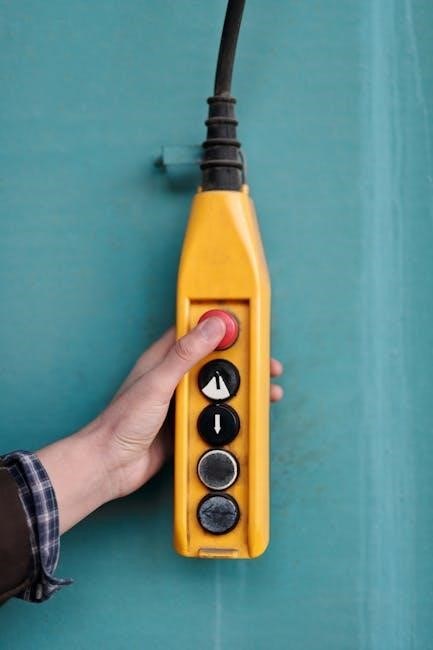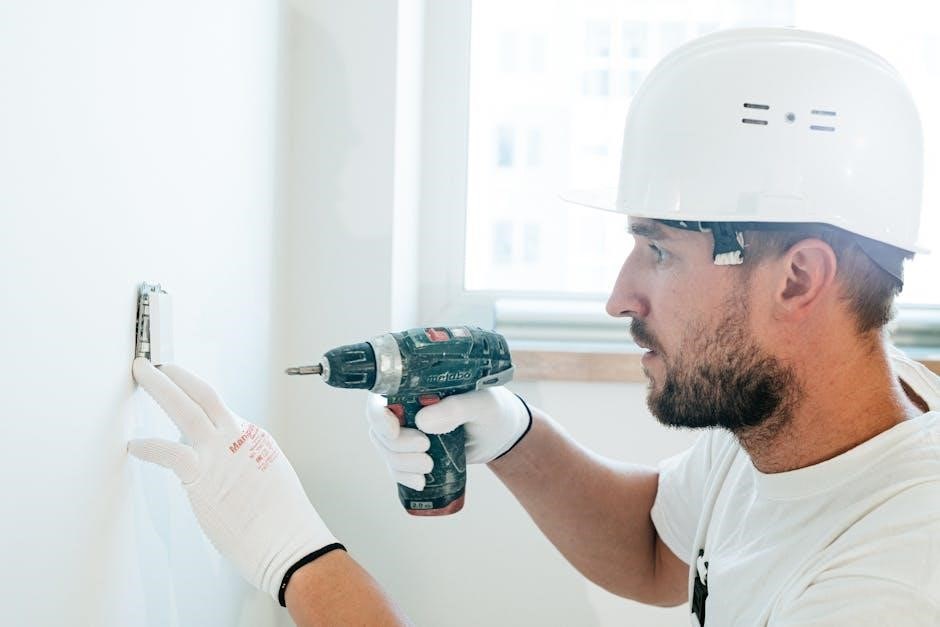This manual provides essential guidance for operating and maintaining a shredder, ensuring safe and efficient use. It covers key features, safety protocols, and best practices for optimal performance.
1.1 Purpose of the Manual
This manual serves as a comprehensive guide for shredder operation, detailing safety measures, component functions, and maintenance tips. It ensures users understand proper procedures to maximize efficiency and security. The manual addresses common issues, provides troubleshooting solutions, and outlines best practices for handling materials. By following the guidelines, users can optimize shredder performance, reduce risks, and extend the machine’s lifespan. It is designed for both novice and experienced users, offering clear instructions for every aspect of shredder use and care.
1.2 Importance of Proper Shredder Operation
Proper shredder operation ensures safety, efficiency, and data protection. Improper use can lead to machine damage, workplace accidents, and security breaches. Following guidelines prevents jams, reduces wear and tear, and maintains optimal performance. It also ensures compliance with security standards, safeguarding sensitive information. Regular maintenance and adherence to safety protocols extend the shredder’s lifespan and protect users from potential hazards. Correct operation is essential for maximizing productivity and maintaining a secure working environment.

Understanding Shredder Components
Understanding shredder components is crucial for effective operation. Key parts include the shredding unit, motor, and control panel. Each component plays a vital role in ensuring smooth functionality and safety.
2.1 Overview of Shredder Parts
A shredder consists of several key components, including the shredding unit, motor, control panel, and waste bin. The shredding unit houses the blades or cutters responsible for processing materials. The motor powers the unit, while the control panel manages operations like start, stop, and reverse functions. Additional features may include sensors for detecting overloads or jams and security settings for sensitive materials. Understanding these parts is essential for proper assembly, operation, and maintenance, ensuring optimal performance and longevity of the shredder.
2.2 Functionality of Each Component
The motor powers the shredder, driving the cutting blades that process materials. The control panel regulates operations, including start, stop, and reverse functions. Sensors detect overloads or jams, ensuring safe operation. The waste bin collects shredded material, while additional features like cooling systems prevent overheating. Each component works together to efficiently shred materials, maintain safety, and extend the shredder’s lifespan. Proper interaction with these parts is crucial for optimal performance and durability.

Safety Precautions
Always wear protective gear like gloves and safety glasses. Keep loose clothing and long hair tied back. Ensure children are kept away from the shredder area.
3.1 General Safety Guidelines
Always read the manual thoroughly before operating the shredder. Understand all safety features and ensure proper installation. Avoid shredding hazardous materials like batteries or flammable items. Keep the shredder on a stable, flat surface and ensure adequate ventilation. Never operate the shredder near water or in humid conditions. Regularly inspect for damage or wear. Follow manufacturer guidelines for load capacity and material types. Maintain a safe distance during operation to prevent accidents.
3.2 Handling Sharp Objects and Blades
Always handle sharp objects and blades with extreme care to avoid injury. Wear protective gloves when interacting with shredder components. Never touch the cutting blades with bare hands, as they are extremely sharp. Use specialized tools to remove jammed materials or clean the shredder. Regularly inspect blades for damage or dullness, as worn blades can lead to unpredictable behavior. Keep sharp parts away from children and unauthorized users to prevent accidents.
3.3 Emergency Stop Procedures
In case of an emergency, immediately press the emergency stop button to halt the shredder. This button is typically located on the control panel and may be under a protective cover to prevent accidental activation. Once pressed, the machine will cease operation instantly. Do not attempt to restart the shredder until the issue is resolved. Ensure all moving parts have stopped before inspecting or clearing any blockages. Always unplug the shredder before performing maintenance or repairs.
Assembly and Installation
Correct assembly and installation are crucial for optimal shredder functionality and safety. Follow the step-by-step guide to ensure all parts are properly aligned and securely fastened. Begin by inspecting all components for damage before assembly. Choose a stable, level surface for installation to prevent vibration and ensure even operation. Refer to the manufacturer’s guidelines for specific instructions tailored to your shredder model.
4.1 Unpacking and Inventory of Parts
Begin by carefully unpacking the shredder and all accessories from the box. Check for any visible damage during shipping. Locate the main shredder unit, shredding blades, collection bin, and power cord. Ensure all components listed in the inventory are present. Cross-reference the parts list to confirm completeness. Inspect each item for signs of damage or defects. Store small or loose parts securely to prevent misplacement. Contact customer support immediately if any items are missing or damaged. Properly organize components before proceeding to assembly.
4.2 Step-by-Step Assembly Instructions
Begin by attaching the shredder blades to the main unit, ensuring they are securely locked in place. Next, connect the motor to the shredder base using the provided bolts. Attach the collection bin to the base by aligning the tabs and securing with clips. Install the control panel by mounting it to the top of the shredder unit. Connect all wiring harnesses to the motor and control panel. Finally, plug in the power cord and test the shredder to ensure proper operation. Follow safety guidelines during assembly.
4.3 Installation Requirements and Recommendations
Ensure the shredder is placed on a flat, stable surface to prevent vibration and tipping. Position it near a power outlet to avoid using extension cords. Maintain proper ventilation to prevent overheating. Install the shredder in a dry, cool environment to protect electrical components. For heavy-duty models, ensure the floor is reinforced to support the weight. Consider grounding the unit for added safety. Professional installation is recommended for large or industrial shredders to ensure compliance with safety standards and optimal performance.

Operating Instructions
Start by powering on the shredder and ensure all materials are prepared. Feed items evenly, avoiding overloading. Monitor operation for smooth performance and adjust settings as needed. Refer to material-specific guidelines for optimal shredding results and safety.
5.1 Preparing Materials for Shredding
Before shredding, remove staples, clips, and bindings. Sort materials by type and thickness. Ensure documents are aligned and folded to fit the shredder’s feed slot. Avoid shredding oversized items, as they may cause jams. Separate sensitive materials for secure shredding. Remove plastic sleeves or non-paper items, as they can damage blades. Check for prohibited items like CDs or metal, which require specialized shredders. Proper preparation ensures efficient and safe operation.
5.2 Starting and Monitoring the Shredder
Plug in the shredder and ensure it is placed on a stable, flat surface. Turn it on and let it run for a few seconds to ensure proper function. Feed materials evenly, avoiding overloading. Monitor the shredder’s progress, checking for jams or blockages. Use the reverse function if needed. Keep the bin below the recommended level to prevent overflow. Always stay attentive during operation and maintain a safe distance. Regular checks ensure smooth and efficient shredding.
5.3 Adjusting Settings for Different Materials
To optimize shredding efficiency, adjust settings based on material type. Use the “standard” setting for regular paper, “thick” for cardboard or sturdy plastics, and “delicate” for items like CDs. Refer to the material type chart in the manual for specific guidance. Adjust the speed accordingly: slower for tougher materials and faster for lighter ones. Avoid overloading by monitoring the shredder’s capacity. In case of jams, use the reverse function to clear blockages. Regularly clean the shredder, especially after handling materials like cardboard or plastics, to maintain performance and longevity.
Maintenance and Upkeep
Regularly clean and lubricate the shredder to ensure smooth operation. Check for worn parts and replace them promptly. Follow the manufacturer’s maintenance schedule to prevent damage and extend lifespan. Proper upkeep ensures optimal performance, reduces jams, and maintains efficiency. Always unplug the shredder before performing maintenance tasks. Refer to the manual for specific guidance on lubrication and part inspection.
6.1 Routine Checks and Cleaning
Perform routine checks on the shredder to ensure optimal functionality. Inspect the blades for dullness or damage and clean out dust and debris regularly. Use a soft brush or vacuum to remove particles from the interior. Lubricate moving parts as recommended to maintain smooth operation. Check for misaligned components and tighten any loose screws. Regular cleaning prevents jams and reduces the risk of fire hazards. Always unplug the shredder before performing any maintenance tasks. A well-maintained shredder operates efficiently and lasts longer.
6.2 Lubrication of Moving Parts
Lubrication is essential for maintaining smooth shredder operation. Apply a high-quality machine oil to moving components like gears and bearings. Use a lubricant specifically designed for industrial equipment to reduce friction and prevent overheating. Regularly lubricate every 50 hours of use or after thorough cleaning. Avoid over-lubrication, as it can attract dust and cause maintenance issues. Proper lubrication extends the lifespan of the shredder and ensures consistent performance. Always refer to the manufacturer’s recommendations for the best lubrication schedule and products.
6.3 Replacing Worn or Damaged Components
Regularly inspect shredder components for wear or damage. Replace blades, gears, and other parts when necessary to ensure optimal performance. Use manufacturer-approved replacement parts to maintain quality and safety. Before replacing, disconnect power and follow safety guidelines. Lubricate new components as recommended. Keep spare parts on hand to minimize downtime. Proper replacement prevents further damage and ensures efficient shredding. Always refer to the manual for specific replacement procedures and tool requirements.

Troubleshooting Common Issues
Identify and resolve common shredder issues by consulting the manual. Restart the machine, check for blockages, and ensure proper maintenance. Address problems promptly to avoid further damage.
7.1 Identifying and Diagnosing Problems
Start by observing unusual noises, reduced performance, or jamming. Check for blockages, worn blades, or misaligned parts. Refer to the manual for diagnostic steps. Look for error messages or lights. Perform a power cycle if needed. Ensure materials are compatible and loaded correctly. Regular maintenance can prevent many issues. Keep a log of problems to identify recurring patterns and address them promptly. Always follow safety guidelines when diagnosing shredder malfunctions.
7.2 Resolving Jamming and Blockages
Stop the shredder immediately if a jam occurs. Use the reverse function to release trapped material. Remove large or tangled items manually. Ensure the shredder is unplugged before attempting to clear blockages. Check for overloaded capacity and reduce the material volume. Lubricate cutters if necessary. Avoid using inappropriate materials, as they can cause persistent jams. Consult the manual for specific guidance on clearing blockages safely and effectively to maintain optimal shredder performance and longevity.
7.3 Addressing Noise or Vibration Problems
Excessive noise or vibration may indicate improper installation, misalignment, or worn parts. Ensure the shredder is placed on a level, stable surface. Check for loose screws or bolts and tighten them. Lubricate moving components regularly to reduce friction. Consider using noise-dampening materials or anti-vibration pads. If issues persist, inspect the blades for damage or imbalance and replace them if necessary. Always refer to the manual for specific troubleshooting steps to resolve noise or vibration effectively.

Noise Reduction and Soundproofing
Use soundproofing materials like acoustic panels or vibration dampeners to minimize operational noise. Ensure proper installation and maintain the shredder to reduce noise levels effectively.
8.1 Understanding Shredder Noise Levels
Shredder noise levels vary based on the machine’s size, speed, and material being processed. Typical noise levels range from 50 to 90 decibels, depending on operation intensity. Industrial shredders tend to be louder than office models. Understanding these levels helps in selecting the right shredder for your environment and implementing appropriate sound reduction measures. Regular maintenance and proper material feeding can also minimize noise generation during operation.
8.2 Tips for Minimizing Operational Noise
To reduce shredder noise, ensure proper installation on a stable surface and maintain adequate lubrication of moving parts. Use sound-dampening materials like acoustic panels or noise-reducing barriers around the machine. Operate the shredder at optimal speeds and avoid overloading it, as this can increase noise levels. Regularly clean and maintain the shredder to prevent debris buildup, which can contribute to excess noise. Consider placing the shredder in a well-insulated room or using noise-canceling equipment for further sound reduction.
Energy Efficiency and Cost Savings
Optimize energy use by selecting shredders with high-efficiency motors and operating at recommended speeds. Regular maintenance ensures lower power consumption, reducing costs over time effectively;
9.1 Optimizing Shredder Performance
To maximize energy efficiency, monitor shredder workload and avoid overloading. Use automatic modes to adjust speed based on material thickness. Regularly clean and lubricate moving parts to reduce friction and energy consumption. Ensure blades are sharp, as dull blades increase power usage. Maintain proper alignment of shredder components to prevent unnecessary strain. Schedule periodic performance checks to identify and address inefficiencies promptly. These practices help extend equipment lifespan and minimize operational costs effectively while maintaining productivity.
9.2 Reducing Power Consumption
To reduce power consumption, optimize shredder usage by selecting energy-efficient modes for lighter loads. Adjust settings based on material thickness to avoid unnecessary energy use. Use automatic shut-off features when the shredder is idle. Schedule regular cleaning to maintain efficiency and ensure proper airflow. Monitor usage patterns and avoid continuous operation for extended periods. Consider upgrading to energy-saving motors or smart sensors that optimize power usage dynamically. These practices help lower electricity costs while maintaining performance levels effectively.

Security Features and Data Protection
This section outlines the shredder’s security features and data protection measures to ensure the confidentiality and secure destruction of sensitive materials.
10.1 Ensuring Confidentiality of Shredded Materials
Shredders are designed with advanced security features to ensure the confidentiality of shredded materials. Cross-cut technology, for instance, reduces documents into small, unreadable particles, preventing unauthorized reconstruction of sensitive information. Many models include automatic shut-off when overloaded, reducing the risk of damaged materials. Secure collection bins with lockable lids further protect shredded data from accidental exposure or theft, ensuring compliance with data protection standards. Regular maintenance and proper usage are essential to uphold these security measures effectively.
10.2 Using Shredder Settings for Secure Destruction
Shredder settings play a crucial role in ensuring secure destruction of sensitive materials. Adjusting the shred size and type, such as switching to micro-cut or cross-cut modes, enhances security by reducing documents into smaller, unreadable fragments. Advanced models offer customizable settings for different material types, ensuring optimal destruction. Additionally, some shredders feature multiple user permissions, allowing only authorized individuals to access secure shredding functions. Proper use of these settings guarantees that confidential information remains protected from unauthorized access or reconstruction.

Upgrading and Customizing Your Shredder
Upgrading and customizing your shredder enhances performance and functionality. Install additional features like advanced cutting blades, noise reduction kits, or automated feed systems to optimize efficiency and versatility.
11.1 Compatible Upgrades and Accessories
Explore compatible upgrades to enhance shredder performance. High-quality blades, additional feed trays, and waste bins can boost efficiency. Noise reduction kits and automation features are popular options. Ensure all upgrades align with your shredder’s model for seamless integration. Accessories like oil kits and maintenance tools support long-term functionality. Always refer to the manufacturer’s compatibility list to avoid operational issues and maintain warranty validity.
11.2 DIY Modifications for Enhanced Performance
Discover DIY modifications to enhance your shredder’s performance. Consider adding a cooling system to prevent overheating or upgrading the lubrication method for smoother operation. Custom feeding trays or shredding aids can handle varying materials more efficiently. Always follow safety guidelines and consult the manual before making changes. DIY upgrades can optimize functionality but ensure modifications align with the shredder’s design to maintain reliability and safety.

Environmental Impact and Recycling
Understand the environmental impact of shredding and recycling options; Proper disposal of shredded waste minimizes landfill contributions and supports sustainability. Recycling shredded materials reduces waste significantly.
12.1 Proper Disposal of Shredder Waste
Proper disposal of shredded waste is crucial for environmental sustainability. Recycle paper and cardboard through designated centers. Metal and plastic scraps should be separated and sent to appropriate recycling facilities. Avoid mixing hazardous materials like batteries or electronics with regular shredder waste. Always follow local municipal guidelines for waste disposal to minimize environmental impact and promote eco-friendly practices. Proper segregation ensures materials are processed correctly, reducing landfill dependency and supporting a circular economy.
12.2 Recycling Options for Shredded Materials
Shredded materials like paper, cardboard, and metal can be recycled through local facilities. Separate materials by type to ensure proper processing. Many communities offer specific drop-off points for shredded waste. Check with local recycling centers for acceptable materials and guidelines. Some facilities also accept shredded plastics. Consider participating in community recycling programs to responsibly manage shredded waste and contribute to environmental conservation. Always verify material acceptance criteria to ensure successful recycling.
Adhering to the guidelines ensures optimal performance, safety, and longevity of your shredder through proper operation and maintenance, promoting a safe working environment.
13.1 Summary of Key Operating Practices
Following the guidelines ensures efficient and safe shredder operation. Regular maintenance, proper material preparation, and adherence to safety protocols are crucial. Always monitor the shredder during use and follow manufacturer instructions. Keep the area clean and ensure all users are trained. Addressing issues promptly prevents damage. By maintaining these practices, you optimize performance, reduce risks, and extend the shredder’s lifespan while ensuring environmental compliance and secure document destruction.
13.2 Final Tips for Long-Term Shredder Efficiency
For long-term efficiency, ensure routine lubrication of moving parts and avoid overloading the shredder. Regularly inspect and replace worn blades to maintain performance. Store the shredder in a dry, clean environment to prevent rust. Consider upgrading to energy-efficient models for cost savings; Always follow the manufacturer’s guidelines for maintenance and operation. By prioritizing these practices, you can extend the shredder’s lifespan and ensure consistent, reliable performance over time.

References and Further Reading
Consult the manufacturer’s official guidelines for detailed specifications. Explore industry publications and online forums for additional shredder operation insights and best practices.
14.1 Recommended Resources for Shredder Operation
Access official manufacturer guides for specific models. Utilize online forums and professional organization websites for shredding best practices. Explore tutorials on YouTube for visual guidance; Check industry blogs for updates on safety and efficiency. Refer to local regulations for compliance on waste disposal. Visit manufacturer support pages for troubleshooting tips and FAQs. Engage with communities like Reddit for user experiences and advice. Attend workshops or webinars for advanced shredder maintenance techniques. These resources ensure comprehensive understanding and optimal shredder performance.
14.2 Manufacturer Guidelines and Support
Always refer to the manufacturer’s official guidelines for precise operation. Dedicated support channels, such as toll-free numbers or email, are available for inquiries. Manufacturers often provide detailed training programs or videos. Adhere to their safety and maintenance protocols for optimal performance. Regular software updates may be required for advanced models. Warranty and troubleshooting information are typically included in their documentation. Following these guidelines ensures compliance with safety standards and maximizes shredder reliability and longevity.





